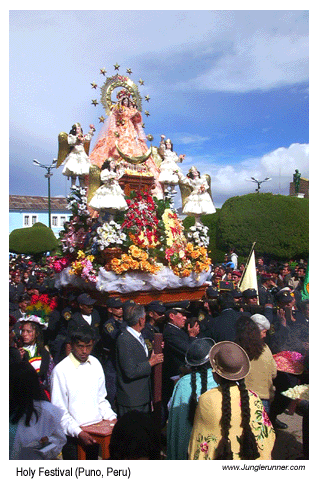
#27 - Peru
Jeff Willner - 7 February
(Lima, PERU) - Peru is well and truly on the gringo circuit. A mecca
for two week escapists, the Lima/Cusco/Titicaca route funnels loads
of camera toting foreigners. When we arrived in Puno on the shore of
Lake Titicaca the touts hit us coming off the bus in full force, "Special
rate for you, very nice hotel, hot water all day!" There are pluses
and minuses to being on a well travelled tourist route. Internet access
is easy and the budget options are usually plentiful. But on the flipside,
it is hard to get past the veneer of backpacker amenities. In the end,
the local culture is reduced to mass produced alpaca sweaters and Inca
styled textiles.
We were lucky to arrive in Puna at the beginning of a major fiesta,
the Virgin de la Candelaria, and were able to see some really unique
stuff. But much of Peru was in seen in the company of package groups
and other budget tourists. Even so, Peru deserves it's status as one
of the top South American destinations. There is no other place where
so many completely different sights are packed so closely together.
And from a purely historical perspective, the rise of the Inca empire
and subsequent invasion by Spanish profiteers is compelling reading.
If you have never been to South America and are looking for a place
to start, Peru is that place.
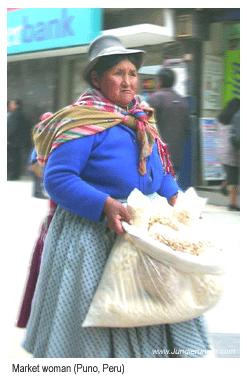 Coming
off the dizzying heights of La Paz, Bolivia, the Lake Titicaca
region was a blessed descent. Though for most visitors it
is advisable to take it easy - after all at over 2000m it
is the world's highest navigable lake. The main attractions
are the floating islands. Centuries ago, a local Indian tribe
began weaving reeds together to make large floating platforms
on which they could build small villages. As the reeds decay
in the water, new layers are added on the top. Some of the
islands are over a hundred years old. Coming
off the dizzying heights of La Paz, Bolivia, the Lake Titicaca
region was a blessed descent. Though for most visitors it
is advisable to take it easy - after all at over 2000m it
is the world's highest navigable lake. The main attractions
are the floating islands. Centuries ago, a local Indian tribe
began weaving reeds together to make large floating platforms
on which they could build small villages. As the reeds decay
in the water, new layers are added on the top. Some of the
islands are over a hundred years old. Having seen the islands
on a previous trip, I stayed in the hotel
and worked on journals. Taking a break
from the computer I wandered down Puno's
three-block gringo alley. A pedestrian
street packed with restaurants, internet
cafes, tour agencies, and shops. Many Indian
women sit in the side alleys selling food
and souvenirs. I passed this little woman
on her way to sell peanuts and snapped
a quick picture. We
were very fortunate in Puno to
arrive at the same time at
the Candelmas fiesta. Thousands of people
thronged
the Plaza de Armas (main square) for
the procession of the Virgin, marching
bands,
and other entertainment. We saw gauchos
(cowboys), regional marching groups that
had bussed in from all over the country,
and everywhere there were families clutching
a picture of the Virgin de la Candelaria
(Virgin Mary with candles). |
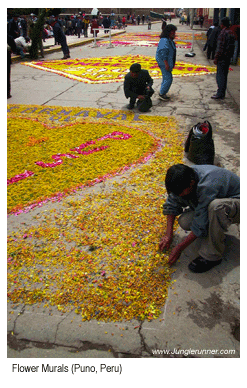 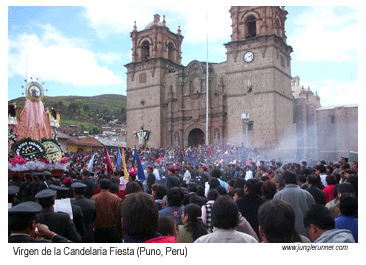 It was raining on Saturday and we expected that to put a damper
on the celebrations. But in the early afternoon the sky cleared
and immediately men with flowers began creating large murals
on the parade route. It was raining on Saturday and we expected that to put a damper
on the celebrations. But in the early afternoon the sky cleared
and immediately men with flowers began creating large murals
on the parade route. Less than an hour later
a massive parade had formed up following
a shoulder carried statue of the Virgin,
and they tramped toward the cathedral directly
on top of the carefully crafted flower
murals. There were at least a dozens stops
in the procession as it inched toward the
cathedral. Incense was offered, prayers
made, flower petals poured onto the figure
from the second storey of a bank building
overlooking the parade route. And everywhere
crowds of people looking on. |
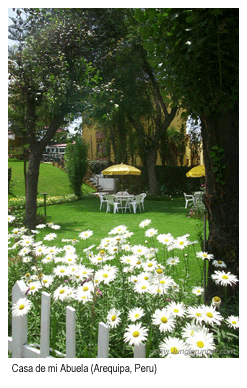 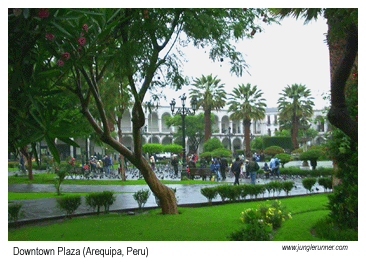 "Just wait till we get to Arequipa, you will love
the hotel there" I assured the women after two days
of cold showers in Puno (the hotel touts lie). I found Casa
de mi Abuela on a previous trip. After a long overnight bus
ride with seats that didn't fully recline, we luxuriated
in an American breakfast on the lawn. Jody left the group
to spend a few days in Machu Picchu but we stayed on for
two days soaking up the easy life in Arequipa - even managed
to catch the Super Bowl. Most of the backpackers in the bar
were watching 'The Exorcist' on another screen so I divided
my attention between the two. I'm not sure which was more
terrifying, Linda Blair's spinning head or the Patriot's
last second march down the field toward their winning field
goal. "Just wait till we get to Arequipa, you will love
the hotel there" I assured the women after two days
of cold showers in Puno (the hotel touts lie). I found Casa
de mi Abuela on a previous trip. After a long overnight bus
ride with seats that didn't fully recline, we luxuriated
in an American breakfast on the lawn. Jody left the group
to spend a few days in Machu Picchu but we stayed on for
two days soaking up the easy life in Arequipa - even managed
to catch the Super Bowl. Most of the backpackers in the bar
were watching 'The Exorcist' on another screen so I divided
my attention between the two. I'm not sure which was more
terrifying, Linda Blair's spinning head or the Patriot's
last second march down the field toward their winning field
goal. |
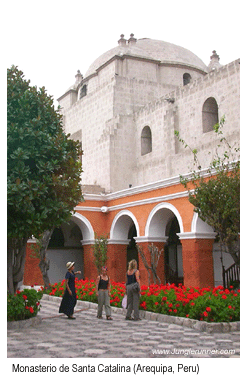 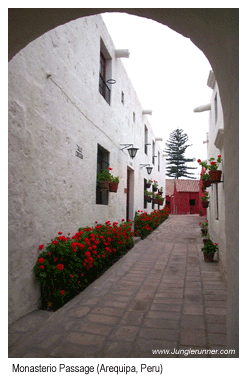 Another of Arequipa's charms is the Monasterio de Santa
Catalina. It is actually a convent, originally founded by
wealthy Spanish nuns seeking a place of refuge. It is not
a building, but rather a city within the city covering over
20,000 sq meters. The maze of streets and alleys hide delightful
gardens and the occasional surprise. Unexpected courtyards
painted a brilliant blue or red are juxtaposed with lush
beds of flowers and the the distinctive white volcanic brick
architecture unique to Arequipa. It really is a photographer's
dream location. You can follow the sun all day going from
one angle to the next, here a fountain, there a cluster of
doves on a blackened old baking furnace. It's one of my favourite
spots in the world. Another of Arequipa's charms is the Monasterio de Santa
Catalina. It is actually a convent, originally founded by
wealthy Spanish nuns seeking a place of refuge. It is not
a building, but rather a city within the city covering over
20,000 sq meters. The maze of streets and alleys hide delightful
gardens and the occasional surprise. Unexpected courtyards
painted a brilliant blue or red are juxtaposed with lush
beds of flowers and the the distinctive white volcanic brick
architecture unique to Arequipa. It really is a photographer's
dream location. You can follow the sun all day going from
one angle to the next, here a fountain, there a cluster of
doves on a blackened old baking furnace. It's one of my favourite
spots in the world. |
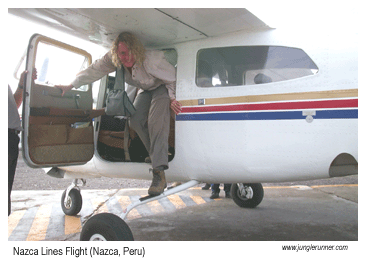 |
Another
all-night bus took us from Arequipa to Nazca, location of
the famous Nazca Lines. For decades controversy swirled around
the lines. Landing strip for aliens! proclaimed one noted
German writer. Others decided they were obscure astrological
signs. From the bone dry desert ground there is nothing special
about the piles of rocks thrown about. It is only from the
air that you see amazing shapes take form. A monkey, hummingbird,
whale, even what looks to be an alien figure picked out on
the side of a mountain. How the pre-Incan cultures were able
to make these large rock figures is a mystery, but even more
intriguing was why. Why would they make these fantastic shapes
when they could only be appreciated from the air - and they
did not know how to fly. Recent theories suggest that the
shamans (or medicine men) went into drug induced trances
in which they perceived that they were flying above the earth.
So the figures may have been created for their benefit. But
the jury is still out on a conclusive answer. |
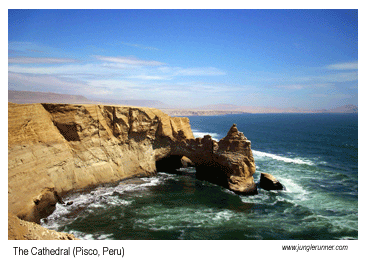 |
Hopping
the community bus for $3 we travelled to Pisco on the coast.
Peru has a cold water current that runs up the coast, similar
to the west coast of southern Africa, which keeps the land
desert dry. In our hired Toyota station wagon we bumped around
the nearby Peninsula de Paracas. Not much to report really.
Lots of sand. Some dunes. And this one particular overlook
onto a natural arch carved out by the sea that is known as
the Cathedral. Oh, Pisco is also renowned
as the home of the white grape brandy
that is used to make the infamous Pisco
Sour. Cheers. |
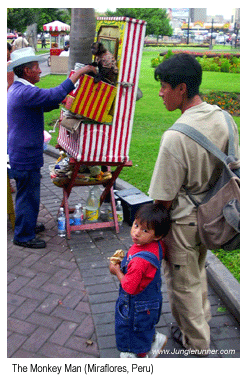 Though we were hoping to transit Lima and catch a same day flight
to Ecuador, it was not to be. We were forced to spend a night
in the capitol. This is not a particularly pleasant prospect.
Lima is a big, dirty city of over two million inhabitants.
Both Sally and I had been forced to spend time there previously,
but we were pleasantly surprised this time when we took a
cab out to the suburb of Miraflores. I gotta tell you, the
government is getting their act together on street cleaning
and beautification in the downtown part of Lima, and Miraflores
(which was always pretty decent) is darn swanky. We strolled
through clean, well-lit parks, past a string of high class
restaurants, and stuffed ourselves at a KFC. Can't get enough
of that original recipe. In fact, after a movie, drinks at
one restaurant, capirinias at a second, and a Romeo y Juliet
cigar from a corner smoke shop - Miraflores seemed like a
heckova good stopover. Though we were hoping to transit Lima and catch a same day flight
to Ecuador, it was not to be. We were forced to spend a night
in the capitol. This is not a particularly pleasant prospect.
Lima is a big, dirty city of over two million inhabitants.
Both Sally and I had been forced to spend time there previously,
but we were pleasantly surprised this time when we took a
cab out to the suburb of Miraflores. I gotta tell you, the
government is getting their act together on street cleaning
and beautification in the downtown part of Lima, and Miraflores
(which was always pretty decent) is darn swanky. We strolled
through clean, well-lit parks, past a string of high class
restaurants, and stuffed ourselves at a KFC. Can't get enough
of that original recipe. In fact, after a movie, drinks at
one restaurant, capirinias at a second, and a Romeo y Juliet
cigar from a corner smoke shop - Miraflores seemed like a
heckova good stopover. As Sally said, you travel
to many places and get used to the local
perception of 'clean'. Most South American
countries stop well short of our first-world
definition of decent. But every once in
awhile, you get to a hotel and walk into
a bathroom with shiny clean ceramic tile,
fresh toilet paper, and no noticeable odour
- and it hits you how much you have been
putting up with. It sounds funny to say,
but at the sight of the spotless bathroom
in our Miraflores hotel, we both flopped
down on our beds and let out a sigh of
contentment. Maybe we were on the gringo
trail, but sometimes a 3-piece KFC meal
combo and a functional flushing toilet
is cultural perfection. |
|


 Coming
off the dizzying heights of La Paz, Bolivia, the Lake Titicaca
region was a blessed descent. Though for most visitors it
is advisable to take it easy - after all at over 2000m it
is the world's highest navigable lake. The main attractions
are the floating islands. Centuries ago, a local Indian tribe
began weaving reeds together to make large floating platforms
on which they could build small villages. As the reeds decay
in the water, new layers are added on the top. Some of the
islands are over a hundred years old.
Coming
off the dizzying heights of La Paz, Bolivia, the Lake Titicaca
region was a blessed descent. Though for most visitors it
is advisable to take it easy - after all at over 2000m it
is the world's highest navigable lake. The main attractions
are the floating islands. Centuries ago, a local Indian tribe
began weaving reeds together to make large floating platforms
on which they could build small villages. As the reeds decay
in the water, new layers are added on the top. Some of the
islands are over a hundred years old. 
 It was raining on Saturday and we expected that to put a damper
on the celebrations. But in the early afternoon the sky cleared
and immediately men with flowers began creating large murals
on the parade route.
It was raining on Saturday and we expected that to put a damper
on the celebrations. But in the early afternoon the sky cleared
and immediately men with flowers began creating large murals
on the parade route. 
 "Just wait till we get to Arequipa, you will love
the hotel there" I assured the women after two days
of cold showers in Puno (the hotel touts lie). I found Casa
de mi Abuela on a previous trip. After a long overnight bus
ride with seats that didn't fully recline, we luxuriated
in an American breakfast on the lawn. Jody left the group
to spend a few days in Machu Picchu but we stayed on for
two days soaking up the easy life in Arequipa - even managed
to catch the Super Bowl. Most of the backpackers in the bar
were watching 'The Exorcist' on another screen so I divided
my attention between the two. I'm not sure which was more
terrifying, Linda Blair's spinning head or the Patriot's
last second march down the field toward their winning field
goal.
"Just wait till we get to Arequipa, you will love
the hotel there" I assured the women after two days
of cold showers in Puno (the hotel touts lie). I found Casa
de mi Abuela on a previous trip. After a long overnight bus
ride with seats that didn't fully recline, we luxuriated
in an American breakfast on the lawn. Jody left the group
to spend a few days in Machu Picchu but we stayed on for
two days soaking up the easy life in Arequipa - even managed
to catch the Super Bowl. Most of the backpackers in the bar
were watching 'The Exorcist' on another screen so I divided
my attention between the two. I'm not sure which was more
terrifying, Linda Blair's spinning head or the Patriot's
last second march down the field toward their winning field
goal. 
 Another of Arequipa's charms is the Monasterio de Santa
Catalina. It is actually a convent, originally founded by
wealthy Spanish nuns seeking a place of refuge. It is not
a building, but rather a city within the city covering over
20,000 sq meters. The maze of streets and alleys hide delightful
gardens and the occasional surprise. Unexpected courtyards
painted a brilliant blue or red are juxtaposed with lush
beds of flowers and the the distinctive white volcanic brick
architecture unique to Arequipa. It really is a photographer's
dream location. You can follow the sun all day going from
one angle to the next, here a fountain, there a cluster of
doves on a blackened old baking furnace. It's one of my favourite
spots in the world.
Another of Arequipa's charms is the Monasterio de Santa
Catalina. It is actually a convent, originally founded by
wealthy Spanish nuns seeking a place of refuge. It is not
a building, but rather a city within the city covering over
20,000 sq meters. The maze of streets and alleys hide delightful
gardens and the occasional surprise. Unexpected courtyards
painted a brilliant blue or red are juxtaposed with lush
beds of flowers and the the distinctive white volcanic brick
architecture unique to Arequipa. It really is a photographer's
dream location. You can follow the sun all day going from
one angle to the next, here a fountain, there a cluster of
doves on a blackened old baking furnace. It's one of my favourite
spots in the world. 

 Though we were hoping to transit Lima and catch a same day flight
to Ecuador, it was not to be. We were forced to spend a night
in the capitol. This is not a particularly pleasant prospect.
Lima is a big, dirty city of over two million inhabitants.
Both Sally and I had been forced to spend time there previously,
but we were pleasantly surprised this time when we took a
cab out to the suburb of Miraflores. I gotta tell you, the
government is getting their act together on street cleaning
and beautification in the downtown part of Lima, and Miraflores
(which was always pretty decent) is darn swanky. We strolled
through clean, well-lit parks, past a string of high class
restaurants, and stuffed ourselves at a KFC. Can't get enough
of that original recipe. In fact, after a movie, drinks at
one restaurant, capirinias at a second, and a Romeo y Juliet
cigar from a corner smoke shop - Miraflores seemed like a
heckova good stopover.
Though we were hoping to transit Lima and catch a same day flight
to Ecuador, it was not to be. We were forced to spend a night
in the capitol. This is not a particularly pleasant prospect.
Lima is a big, dirty city of over two million inhabitants.
Both Sally and I had been forced to spend time there previously,
but we were pleasantly surprised this time when we took a
cab out to the suburb of Miraflores. I gotta tell you, the
government is getting their act together on street cleaning
and beautification in the downtown part of Lima, and Miraflores
(which was always pretty decent) is darn swanky. We strolled
through clean, well-lit parks, past a string of high class
restaurants, and stuffed ourselves at a KFC. Can't get enough
of that original recipe. In fact, after a movie, drinks at
one restaurant, capirinias at a second, and a Romeo y Juliet
cigar from a corner smoke shop - Miraflores seemed like a
heckova good stopover.